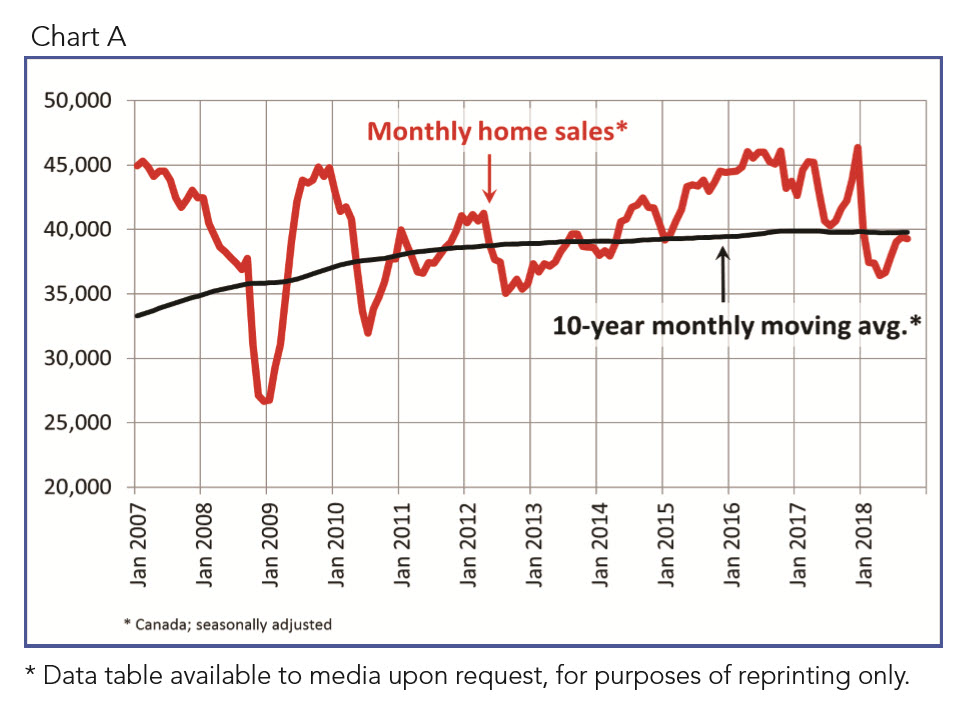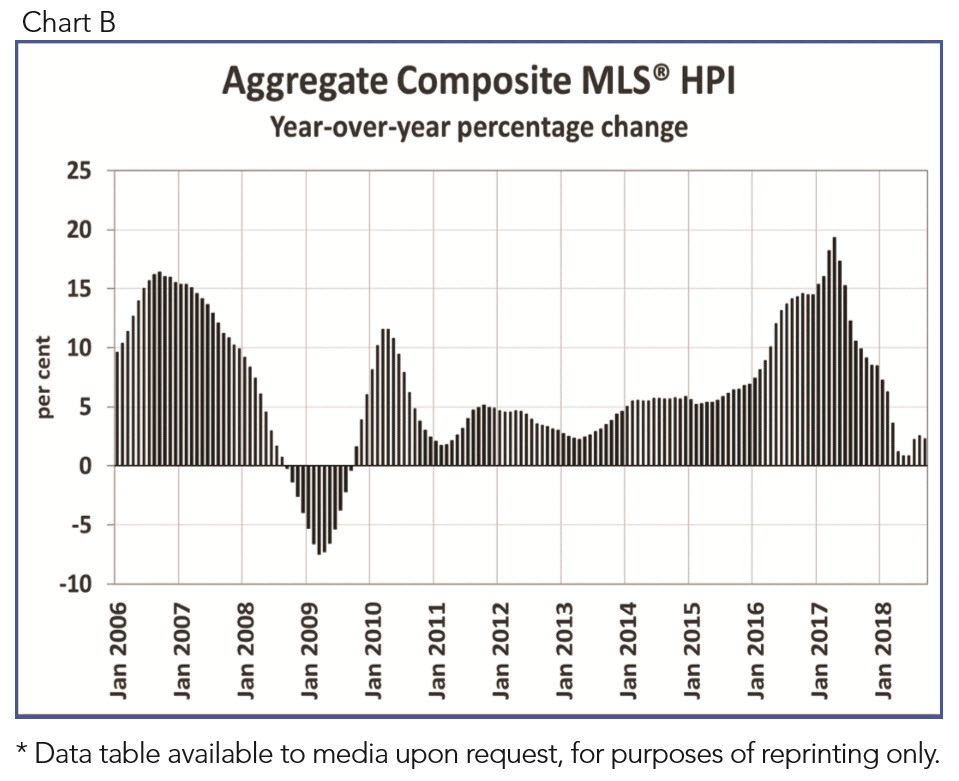
15 Oct Canadian home sales activity edges lower in September
Ottawa, ON, October 15, 2018 – Statistics released today by The Canadian Real Estate Association (CREA) show national home sales edged down slightly between August and September 2018.
Highlights:
- National home sales edged back 0.4% from August to September.
- Actual (not seasonally adjusted) activity was down by 8.9% from one year ago.
- The number of newly listed homes rose by 3% from August to September.
- The MLS® Home Price Index (HPI) was up 2.3% year-over-year (y-o-y) in September.
- The national average sale price edged up a slight 0.2% y-o-y in September.
National home sales via Canadian MLS® Systems eased by 0.4% in September 2018, marking the first decline since April. While sales activity is still somewhat stronger compared to the first half of this year, it remains well below most other months since 2014. (Chart A)
Sales declined from August to September in slightly more than half of all local markets, led by Vancouver Island and Edmonton, along with several markets in Ontario’s Greater Golden Horseshoe (GGH) Region. Activity declines in these markets were offset by monthly gains in the Fraser Valley and Montreal.
Actual (not seasonally adjusted) activity was down 8.9% compared to September 2017.
About 70% of local markets were down on a y-o-y basis, led primarily by declines in major urban centres in British Columbia, along with Calgary, Edmonton and Winnipeg.
“The balance between the number of home buyers and suitable homes varies depending on location, housing type and price range,” said CREA President Barb Sukkau. “Differences in market balance will likely come into sharper focus as interest rates rise and cause this year’s new mortgage stress-test to become even more restrictive. A professional REALTOR® is your best source for information and guidance in negotiating a purchase or sale of a home during these changing times,” said Sukkau.
The number of newly listed homes rose 3% between August and September, led by the Lower Mainland and the Greater Toronto Area (GTA). More than half of all local markets posted a monthly increase in new listings, which was offset by declines in excess of 3% in more than half of the remaining local markets.
“Sales activity may get all the press but it’s the balance between that and the number of homes for sale that sets the tone for pricing environment,” said Gregory Klump, CREA’s Chief Economist. “In markets with an abundant supply of homes and slower sales activity, buyers have the upper hand when it comes to negotiations over price. However, in places where buyers are keen to make a purchase but there’s a shortage of homes for sale, sellers are in the driver’s seat when it comes to price. It will be interesting to see how supply and demand
respond to rising interest rates amid this year’s new mortgage stress-test.”
With sales down slightly and new listings up, the national sales-to-new listings ratio eased to 54.4% in September compared to 56.2% in July and August. The long-term average for this measure of market balance is 53.4%.
Considering the degree and duration to which market balance readings are above or below their long-term average is a way of gauging whether local housing market conditions favour buyers or sellers. As a rule of thumb, measures of market balance that are within one standard deviation of their long-term average are generally consistent with balanced market conditions.
Based on a comparison of the sales-to-new listings ratio with the long-term average, about three-quarters of all local markets were in balanced market territory in September 2018.
The number of months of inventory is another important measure for the balance between housing supply and demand. It represents how long it would take to liquidate current inventories at the current rate of sales activity.
There were 5.3 months of inventory on a national basis at the end of August 2018. While this is in line with the measure’s long-term average nationally, the number of months of inventory is well above its long-term average in all Prairie provinces and in Newfoundland & Labrador.
The Aggregate Composite MLS® Home Price Index (MLS® HPI) was up 2.3% y-o-y in September 2018. The increase was in line with those posted in each of the two previous months. (Chart B)
Apartment units posted the largest y-o-y price gains in September (+8.4%), followed by townhouse/row units (+4.5%). Meanwhile, one-storey and two-storey single family home prices were little changed on a y-o-y basis in September (-0.3% and -0.3% respectively).
Trends continue to vary widely among the 17 housing markets tracked by the MLS® HPI. In British Columbia, home price gains are diminishing on a y-o-y basis in the Lower Mainland (Greater Vancouver (GVA): +2.2%; Fraser Valley: +8.5%). Meanwhile, prices in Victoria were up 8.7% y-o-y in September. Elsewhere on Vancouver Island they climbed 13.2%.
Among the housing markets in the Greater Golden Horseshoe region that are tracked by the index, home prices were up from year-ago levels in Guelph (+8%), Hamilton-Burlington (+6.1%), the Niagara Region (+5.9%), the GTA (+2%), and Oakville-Milton (+1.4%). By contrast, home prices slipped lower in Barrie and District (-3.6%).
Across the Prairies, benchmark home prices remained below year-ago levels in Calgary (-2.6%), Edmonton (-2.6%), Regina (-4.7%) and Saskatoon (-1.9%).
Home prices rose by 6.9% y-o-y in Ottawa (led by an 7.9% increase in two-storey single family home prices), by 6.1% in Greater Montreal (led by a 7% increase in townhouse/row unit prices) and by 3.4% in Greater Moncton (led by a 10.3% increase in apartment unit prices). (Table 1)
The MLS® HPI provides the best way of gauging price trends because average price trends are strongly distorted by changes in the mix of sales activity from one month to the next.
The actual (not seasonally adjusted) national average price for homes sold in September 2018 was just under $487,000, little changed (+0.2%) from the same month last year.
The national average price is heavily skewed by sales in the GVA and GTA, two of Canada’s most active and expensive markets. Excluding these two markets from calculations cuts almost $104,000 from the national average price, trimming it to just over $383,000.
– 30 –
PLEASE NOTE: The information contained in this news release combines both major market and national sales information from MLS® Systems from the previous month.
CREA cautions that average price information can be useful in establishing trends over time, but does not indicate actual prices in centres comprised of widely divergent neighbourhoods or account for price differential between geographic areas. Statistical information contained in this report includes all housing types.
MLS® Systems are co-operative marketing systems used only by Canada’s real estate Boards to ensure maximum exposure of properties listed for sale.
The Canadian Real Estate Association (CREA) is one of Canada’s largest single-industry trade associations. CREA works on behalf of more than 125,000 REALTORS® who contribute to the economic and social well-being of communities across Canada. Together they advocate for property owners, buyers and sellers.
Further information can be found at http://crea.ca/statistics.
For more information, please contact:
Pierre Leduc, Media Relations
The Canadian Real Estate Association
Tel.: 613-237-7111 or 613-884-1460
E-mail: pleduc@crea.ca




